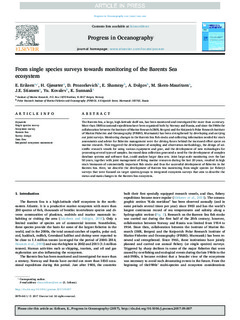| dc.description.abstract | The Barents Sea, a large, high-latitude shelf sea, has been monitored and investigated for more than a century. More than 1800 occasional expeditions have been organized both by Norway and Russia, and since the1960s the collaboration between the Institute of Marine Research (IMR, Bergen) and the Knipovich Polar Research Institute of Marine Fisheries and Oceanography (PINRO, Murmansk) has been strengthened by developing and carrying out joint surveys. Monitoring changes in the Barents Sea fish stocks and collecting information needed for stock assessments and advice for fisheries management were the driving forces behind the increased effort spent on marine research. This triggered the development of sampling and observation methodology, the design of scientific research vessels for using various equipment and gear, and the development of new technologies for processing several types of samples. Increased data collection generated a need for the development of complex database systems and software that, could analyze larger data sets. Joint large-scale monitoring over the last 50 years, together with joint management of living marine resources during the last 20 years, resulted in high stock biomasses of commercially important fish stocks and thus the successful development of fisheries in the Barents Sea. Here, we describe the development of Barents Sea monitoring from single species (or fishery) surveys that were focused on target species/groups to integrated ecosystem surveys that aim to describe the status and main changes in the Barents Sea ecosystem. | nb_NO |
